
Creative Commons Attribution-Noncommercial-No Derivative Works 3.0
Plates 2.39-2.40: Font in Winchester Cathedral (Original Explanatory Account)
1 2020-07-14T10:35:51+00:00 Ariel Fried f6b6cec26c5a46c3beae9e3505bac9e8799f51de 31 18 Original Explanatory Account for Vetusta Monumenta, Plates 2.39-2.40. Written by Richard Gough. plain 2021-12-27T23:17:40+00:00 Mary-Claire Sarafianos b64b0f9cad2b567cca4c9f2022b28f5bd47876a6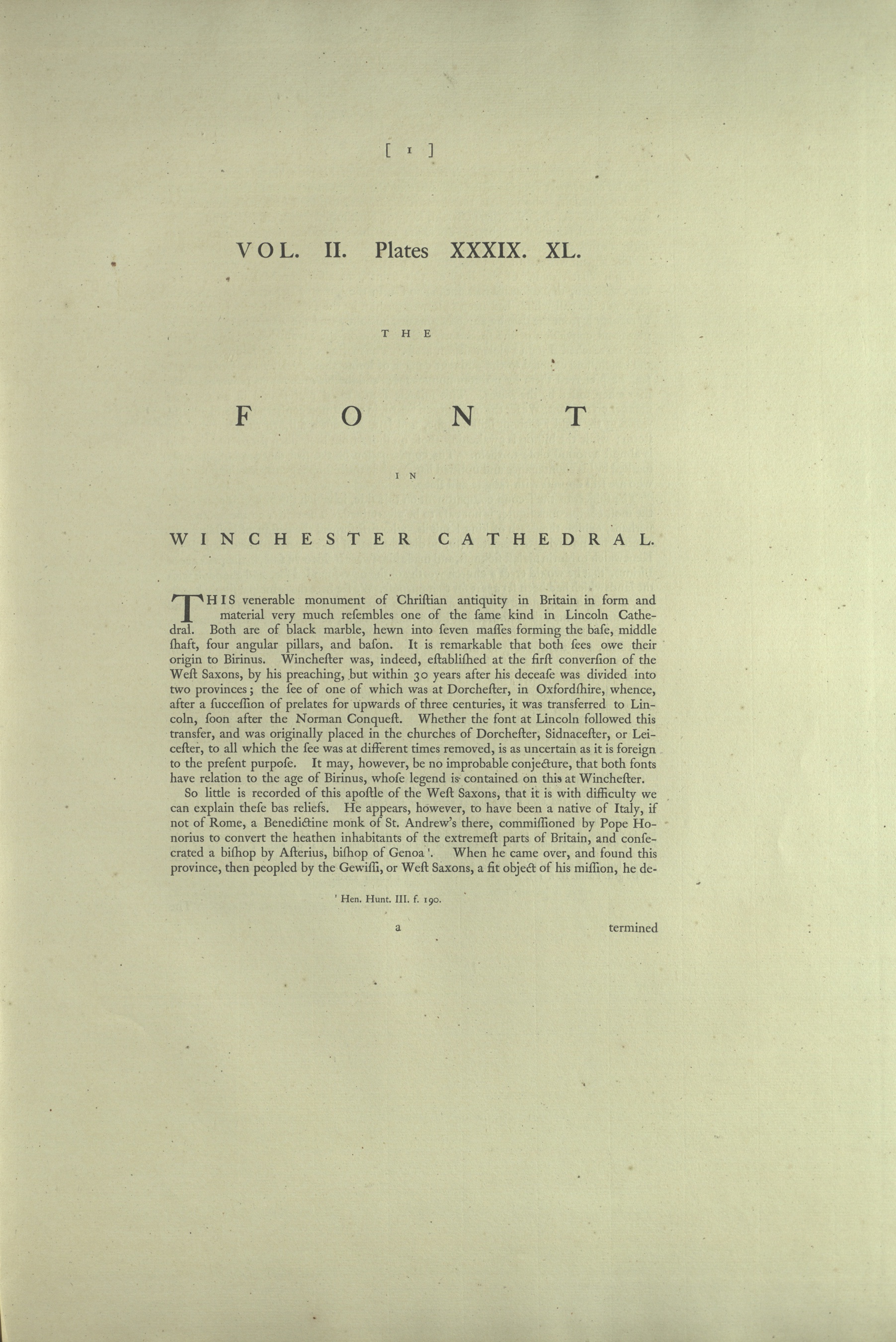
[ (Page) 1 ]
VOL. II. Plates XXXIX. XL.
THE FONT IN WINCHESTER CATHEDRAL.
THIS venerable monument of Christian antiquity in Britain in form and material very much resembles one of the same kind in Lincoln Cathedral.
Read more/less...Both are of black marble, hewn into seven masses forming the base, middle shaft, four angular pillars, and bason. It is remarkable that both sees owe their origin to Birinus. Winchester was, indeed, established at the first conversion of the West Saxons, by his preaching, but within 30 years after his decease was divided into two provinces; the see of one which was at Dorchester, in Oxfordshire, whence, after a succession of prelates for upwards of three centuries, it was transferred to Lincoln, soon after the Norman Conquest. Whether the font at Lincoln followed this transfer, and was originally placed in the churches of Dorchester, Sidnacester, or Leicester, to all which the see was at different times removed, is as uncertain as it is foreign to the present purpose. It may, however, be no improbable conjecture, that both fonts have relation to the age of Birinus, whose legend is contained on this at Winchester.
So little is recorded of this apostle of the West Saxons, that it is with difficulty we can explain these bas reliefs. He appears, however, to have been a native of Italy, if not of Rome, a Benedictine monk of St. Andrew’s there, commissioned by Pope Honorius to convert the heathen inhabitants of the extremest parts of Britain, and consecrated a bishop by Asterius, bishop of Genoa1. When he came over, and found this province, then peopled by the Gewissi, or West Saxons, a fit object of his mission, he de-[termined]
1Hen. Hunt. III. f. 190.

[ (Page) 2 ]
[de-]termined to settle here; and such was the progress of his preaching, that in a short time he converted to the Christian faith not only the common people and the nobility, but the king himself, who at the time was Kinigils, and baptized him with numbers of his subjects. At this solemnity, Oswald, king of Northumberland, assisted, who shortly after married Kinigils’ daughter. These are the short accounts our historians give of Birinus’s first arrival, A.D. 6351.
Read more/less...The legend writers fill up these outlines with miracles.
From what remains of the lives of this Saint2, as also from Malmsbury3, however, we learn, that upon his first putting to sea, in the hurry of departure he happened to forget the pall which had been bestowed upon him by the Pope. It being impossible to recover it from the ship by any other means, he boldly trod the waves, to the astonishment and conviction of the spectators, and brought off the invaluable present. When the ship reached Britain a violent storm arose. The mariners carelessly falling asleep on the beach, and exposed to the eminent danger of losing their lives by the swell of the sea, he preserved them by no common means; and by his miraculous power staid the ship when tossed by the waves. This miracle seems to be represented in an eminent manner on the font. We see the mariners on board, in the utmost consternation and despair, working the rudder without skill or hope, and left, without a sail, to the mercy of the storm; while the bishop is awakening those on shore from their deep sleep, and the ship is almost aground close to them. The consternation of the first that awoke is strongly marked by his countenance and uplifted hands, while the bishop is gently touching the rest, who are still opprest with fatigue and sleep.
The subject of the second compartment on this side, in which the bishop appears again the most conspicuous figure, is not easy to be ascertained. The reliefs on the South side, perhaps, exhibit the death of king Kinigils, who first formed the design of building this church, but not living to execute it (for he died the year of his conversion), he called his son Kenewalch to him in his last sickness, and made him swear by his own soul, in the presence of Birinus, that he would erect a church worthy of the new-founded see, and endow it with the lands which had been set apart for that purpose. We see here the principal figure kneeling, and depositing in the hands of a person in robes and tiara on one side of him, and of a bishop on the other, something like a mass of earth, or stone, alluding, it may be, to the materials collected by Kinigils for this pious work, which his son may be receiving from him, and transferring to the bishop, at the same time binding himself by oath to apply them as directed; and extending his right hand, to fix the attention of one of his suite, who joins his right hand to that of another with the same significance, the latter applying his hand to his breast. The three attendants, of whom one has a hawk on his fist, expressive of his office or rank, may be officers of the court, called to be witnesses to this solemn transaction, which is paralleled in the Jewish history in the charge given by David to his son Solomon to execute his design, and to apply the materials he had collected for building the temple4.
1Bede Eccl. Hist. III. 5. Brompton inter X Scriptores 56. The Saxon Chronicle dates his arrival A.D. 634, and the conversion of Kinigils, 635. Rudburne, in Hist. minor makes him land 628. But presently after follows Malmsbury, and fixes his landing 41 years after the coming of Augustine. Warton’s Ang. Sac, I. 190, note*.
2Of these lives we have two in the Cottonian library: One Tiberius D. IV. more at large, and fairly written, but so damaged by the fire, 1736, that I with difficulty separated the leaves, and thence could scarce collect the matter: the other, Caligula, A. VI. is an abstract of the larger, but imperfect at the end. Two copies of John Tinmouth, Tiberius, E. I. and of Capgrave, Otho, D. IX. in which this life was included among others, were entirely burnt. A metrical life, by Peter bishop of Winchester, Vitell. D. XIV. was also consumed.
3De gest. Pontif. II. f. 137.
4I Chron xxviii.

[ (Page) 3 ]
The church which is seen close to the bishop may be that of Dorchester, where Birinus sat till his death. Though no such front is to be seen at present at Dorchester1, it still boasts one of the handsomest parochial churches in the kingdom.
Read more/less...The style of architecture in the building on the font is perfectly Saxon, with three rows of round arches, the two first separated by a fascia of lozenge work, as at Hereford cathedral; the two uppermost, by a fascia of pellets or rounds, common in Saxon buildings. Over the upper row of arches in the aile we see something like the Saxon zigzag, and below the hatched work, which is frequently repeated at the top, as may be instanced in the remains of many buildings of that time. Here is a North aile, adorned with two upper rows of the same pillars as the front, and in the lower story a singular ornament in the form of a St. Andrew’s cross. The hinges of the great door exactly resemble what we see on ancient church doors, and the lock has the peculiarity of being placed in the middle of the door between them, and sheltered by a small pent house or projecting box.
That this bas relief represented the history of Birinus, and the conversion of king Kinigils, by him will be further confirmed if we compare it with the facts of the same period painted on glass in the windows of the chancel at Dorchester, as well as carved in relief on the mullions of the same, and all still remaining. In the South window of the chancel SANCTVS BIRINUS is inscribed under a rondeau of a bishop with a crosier receiving a cross from a king; another king standing behind the bishop; representing, probably, the investiture of Birinus by Kinigils, at which Oswald assisted. At the bottom of the bars and arch of the upper compartments of this window are the following reliefs of whole figures, representing probably, the consecration of Birinus, and the founding of this see. Three figures in religious habits with books; a bishop with a cross and mitre; two figures with books; two more such; a single one; another with a pot and brush. Mr. Hearne2 says, the history of Birinus’ coming into England and converting the heathens of these parts is painted on the windows of this church. It is probable more remained when he wrote this.
Mr. Warton says, the conversion of Kinigils, king of the Gewysii, or West Saxons, was embroidered on a pall, and represented, with other histories of this saint, on the Norman font at Winchester, on the windows at Dorchester, and the West front and windows at Lincoln3. In a letter to me, dated Oxford, May 28, 1785, Mr. Warton says, “I find at Dorchester the following imageries, either in painted glass or in the masonry of the windows. First window in the North aisle, from the West, the deck of a ship, with a head crowned; Birinus sailing to England. In the second, Birinus baptizing Kinigils, king of the West Saxons; Birinus in a green vestment; Oswald, king of Northumberland, his godfather, with attendants. In the fifth, under a bishop, Sanctus Birinus; near him the figure of Honorius, the Pope who sent him to convert the West Saxons. These are in the glass. In the East window of the choir in the masonry, on the right, first, a figure with long hair and a staff; second, a figure sitting, blessing a female figure kneeling before it: perhaps, Birinus blessing the daughter of Kinigils, before he married her to Oswald. On the left, third a martyrdom; perhaps, the decollation of Birinus. It is highly probable that Birinus is the subject of the font at Winchester. That compartment where the facade of a church appears, is undoubtedly a marriage. The most difficult one is the ship,” &c.
In this explanation we shall perhaps be disposed to concur, and admit the last compartment of the font to represent both the fact before referred to (the building of the church), and the marriage of Oswald with Kinigils’ daughter, whose name no historian
1Hearne thinks Birinus’s church there was of wood.
2Antiquities between Windsor and Oxford, p. 159, at the end of Leland’s Itinerary V. 3d Ed.
3Dissertation prefixed to History of English Poetry.
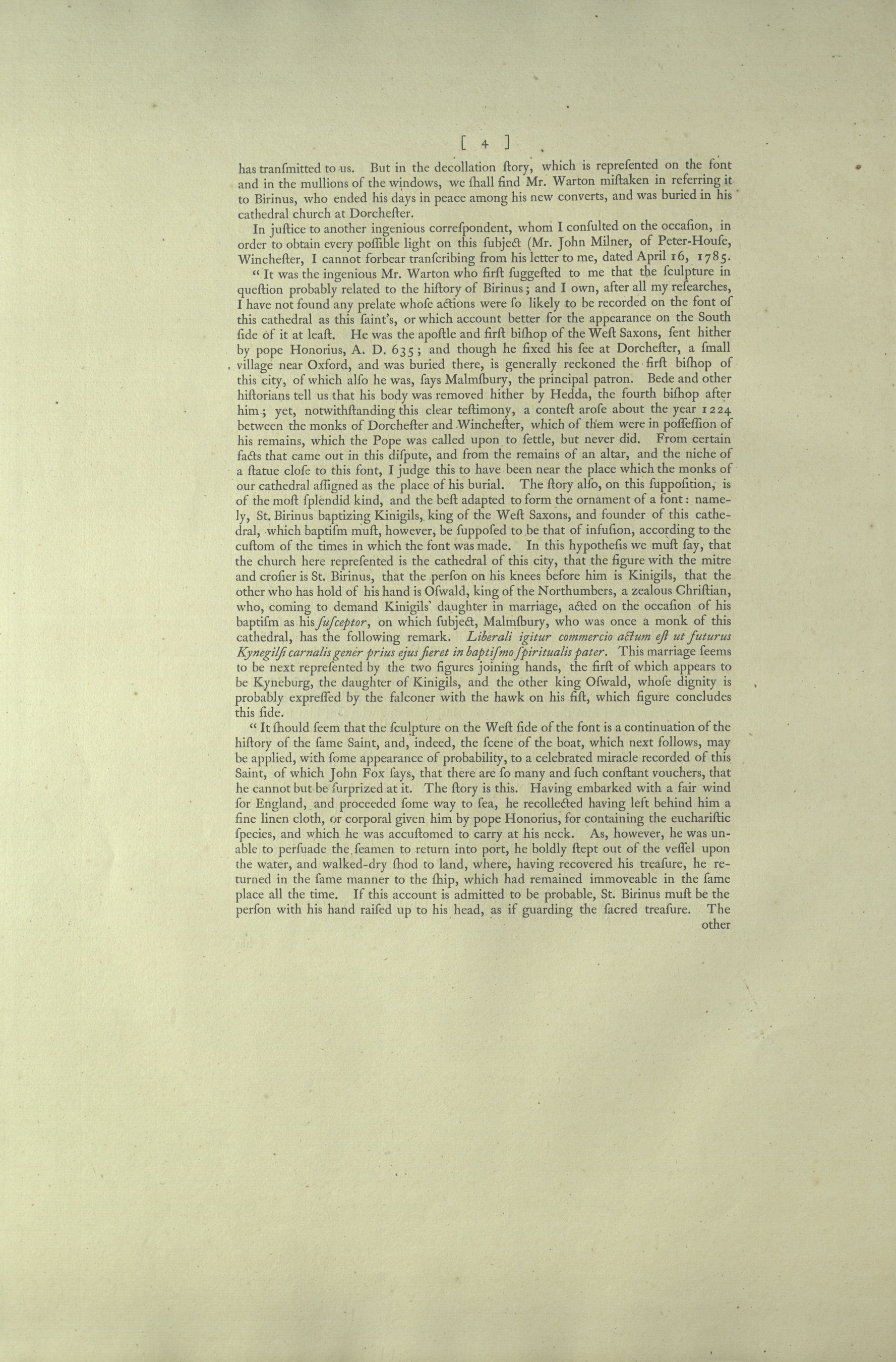
[ (Page) 4 ]
has transmitted to us. But in the decollation story, which is represented on the font and in the mullions of the windows, we shall find Mr. Warton mistaken in referring it to Birinus, who ended his days in peace among his new converts, and was buried in his cathedral church at Dorchester.
Read more/less...In justice to another ingenious correspondent, whom I consulted on the occasion, in order to obtain every possible light on this subject (Mr. John Milner, of Peter-House, Winchester[)], I cannot forbear transcribing from his letter to me, dated April 16, 1785.
“It was the ingenious Mr. Warton who first suggested to me that the sculpture in question probably related to the history of Birinus; and I own, after all my researches, I have not found any prelate whose actions were so likely to be recorded on the font of this cathedral as this saint’s, or which account better for the appearance on the South side of it at least. He was the apostle and first bishop of the West Saxons, sent hither by pope Honorius, A. D. 635; and though he fixed his see at Dorchester, a small village near Oxford, and was buried there, is generally reckoned the first bishop of this city, of which also he was, says Malmsbury, the principal patron. Bede and other historians tell us that his body was removed hither by Hedda, the fourth bishop after him; yet, notwithstanding this clear testimony, a contest arose about the year 1224 between the monks of Dorchester and Winchester, which of them were in possession of his remains, which the Pope was called upon to settle, but never did. From certain facts that came out in this dispute, and from the remains of an altar, and the niche of a statue close to this font, I judge this to have been near the place which the monks of our cathedral assigned as the place of his burial. The story also, on this supposition, is of the most splendid kind, and the best adapted to form the ornament of a font: namely, St. Birinus baptizing Kinigils, king of the West Saxons, and founder of this cathedral, which baptism must, however, be supposed to be that of infusion, according to the custom of the times in which the font was made. In this hypothesis we must say, that the church here represented is the cathedral of this city, that the figure with the mitre and crosier is St. Birinus, that the person on his knees before him is Kinigils, that the other who has hold of his hand is Oswald, king of the Northumbers, a zealous Christian, who, coming to demand Kinigils’ daughter in marriage, acted on the occasion of his baptism as his susceptor, on which subject, Malmsbury, who was once a monk of this cathedral, has the following remark. Liberali igitur commercio actum est ut futurus Kynegilsi carnalis gener prius ejus fieret in baptismo spiritualis pater. [In a gracious exchange it was enacted that the future son-in-law of Cynegils in the flesh became first his spiritual father for the baptism.] This marriage seems to be next represented by the two figures joining hands, the first of which appears to be Kyneburg, the daughter of Kinigils, and the other king Oswald, whose dignity is probably expressed by the falconer with the hawk on his fist, which figure concludes this side.
“It should seem that the sculpture on the West side of the font is a continuation of the history of the same Saint, and, indeed, the scene of the boat, which next follows, may be applied, with some appearance of probability, to a celebrated miracle recorded of this Saint, of which John Fox says, that there are so many and such constant vouchers, that he cannot but be surprized at it. The story is this. Having embarked with a fair wind for England, and proceeded some way to sea, he recollected having left behind him a fine linen cloth, or corporeal given him by pope Honorius, for containing the eucharistic species, and which he was accustomed to carry at his neck. As, however, he was unable to persuade the seamen to return into port, he boldly stept out of the vessel upon the water, and walked-dry shod to land, where, having recovered his treasure, he returned in the same manner to the ship, which had remained immoveable in the same place all the time. If this account is admitted to be probable, St. Birinus must be the person with his hand raised up to his head, as if guarding the sacred treasure. The
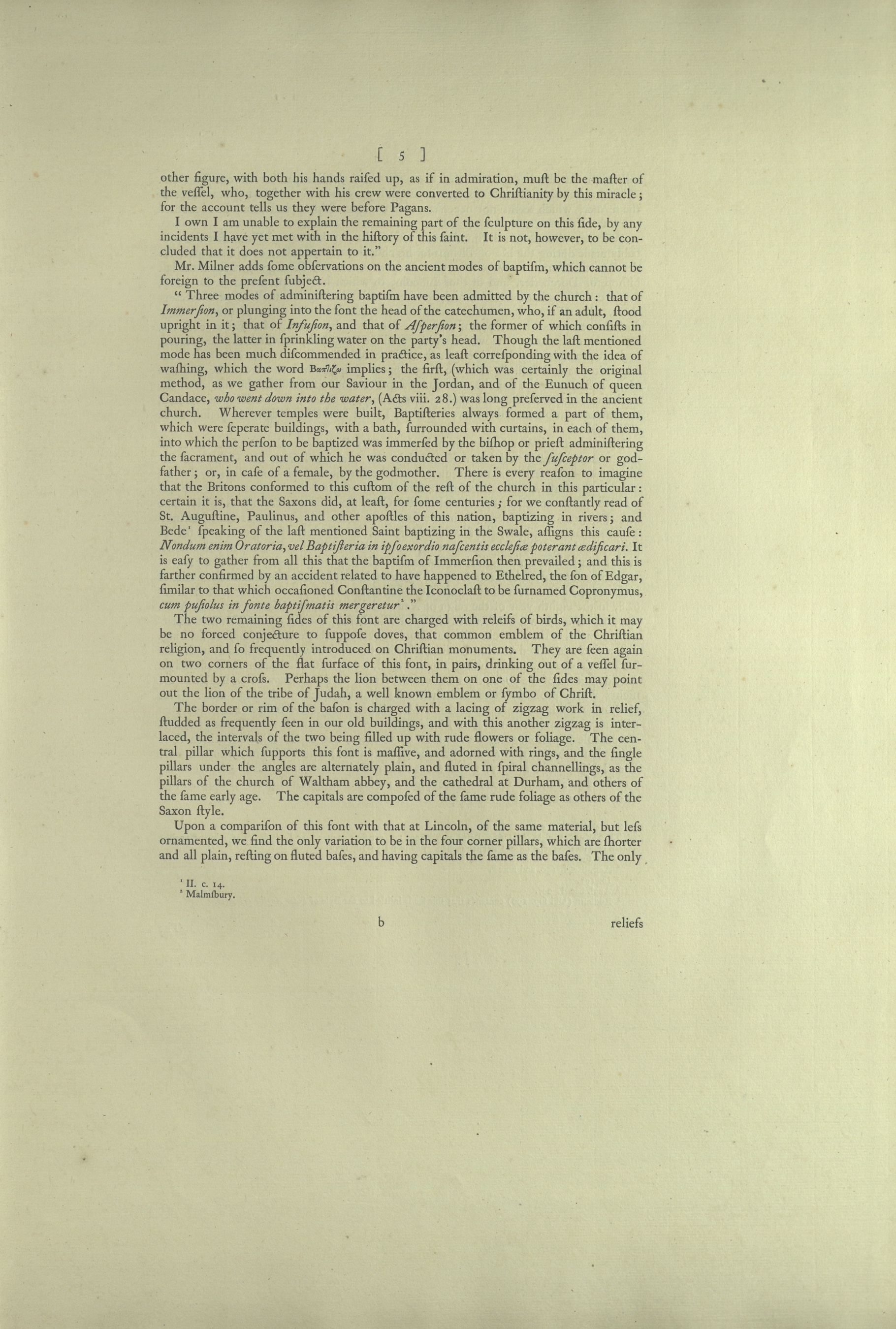
[ (Page) 5 ]
other figure, with both his hands raised up, as if in admiration, must be the master of the vessel, who, together with his crew were converted to Christianity by this miracle; for the account tells us they were before Pagans.
I own I am unable to explain the remaining part of the sculpture on this side, by any incidents I have yet met with in the history of this saint. It is not, however, to be concluded that it does not appertain to it.”
Read more/less...Mr. Milner adds some observations on the ancient modes of baptism, which cannot be foreign to the present subject.
“Three modes of administering baptism have been admitted by the church: that of Immersion, or plunging into the font the head of the catechumen, who, if an adult, stood upright in it; that of Infusion, and that of Aspersion; the former of which consists in pouring, the latter in sprinkling water on the party’s head. Though the last mentioned mode has been much discommended in practice, as least corresponding with the idea of washing, which the word Bαπℸιζω implies; the first, (which was certainly the original method, as we gather from our Saviour in the Jordan, and of the Eunuch of queen Candace, who went down into the water, (Acts viii. 28.)[)] was long preserved in the ancient church. Wherever temples were built, Baptisteries always formed a part of them, which were separate buildings, with a bath, surrounded with curtains, in each of them, into which the person to be baptized was immersed by the bishop or priest administering the sacrament, and out of which he was conducted or taken by the susceptor or godfather; or, in case of a female, by the godmother. There is every reason to imagine that the Britons conformed to this custom of the rest of the church in this particular: certain it is, that the Saxons did, at least, for some centuries; for we constantly read of St. Augustine, Paulinus, and other apostles of this nation, baptizing in rivers; and Bede1 speaking of the last mentioned Saint baptizing in the Swale, assigns this cause: Nondum enim Oratoria, vel Baptisteria in ipsoexordio nascentis ecclesiae poterant aedificari. [For as yet there could not be builded oratories or places of baptism in the very birth of the Church new begun.] It is easy to gather from all this that the baptism of Immersion then prevailed; and this is farther confirmed by an accident related to have happened to Ethelred, the son of Edgar, similar to that which occasioned Constantine the Iconoclast to be surnamed Copronymus, cum pusiolus in fonte baptismatis mergeretur2. [when he, as a young boy, was submerged in the baptismal font]”
The two remaining sides of this font are charged with releifs [sic] of birds, which it may be no forced conjecture to suppose doves, that common emblem of the Christian religion, and so frequently introduced on Christian monuments. They are seen again on two corners of the flat surface of this font, in pairs, drinking out of a vessel surmounted by a cross. Perhaps the lion between them on one of the sides may point out the lion of the tribe of Judah, a well known emblem or symbo[l] of Christ.
The border or rim of the bason is charged with lacing of zigzag work in relief, studded as frequently seen in our old buildings, and with this another zigzag is interlaced, the intervals of the two being filled up with rude flowers or foliage. The central pillar which supports this font is massive, and adorned with rings, and the single pillars under the angles are alternately plain, and fluted in spiral channellings, as the pillars of the church of Waltham abbey, and the cathedral of Durham, and others of the same early age. The capitals are composed of the same rude foliage as others of the Saxon style.
Upon a comparison of this font with that at Lincoln, of the same material, but less ornamented, we find the only variation to be in the four corner pillars, which are shorter and all plain, resting on fluted bases, and having capitals the same as the bases. The only
1II. c. 14
2Malmsbury.
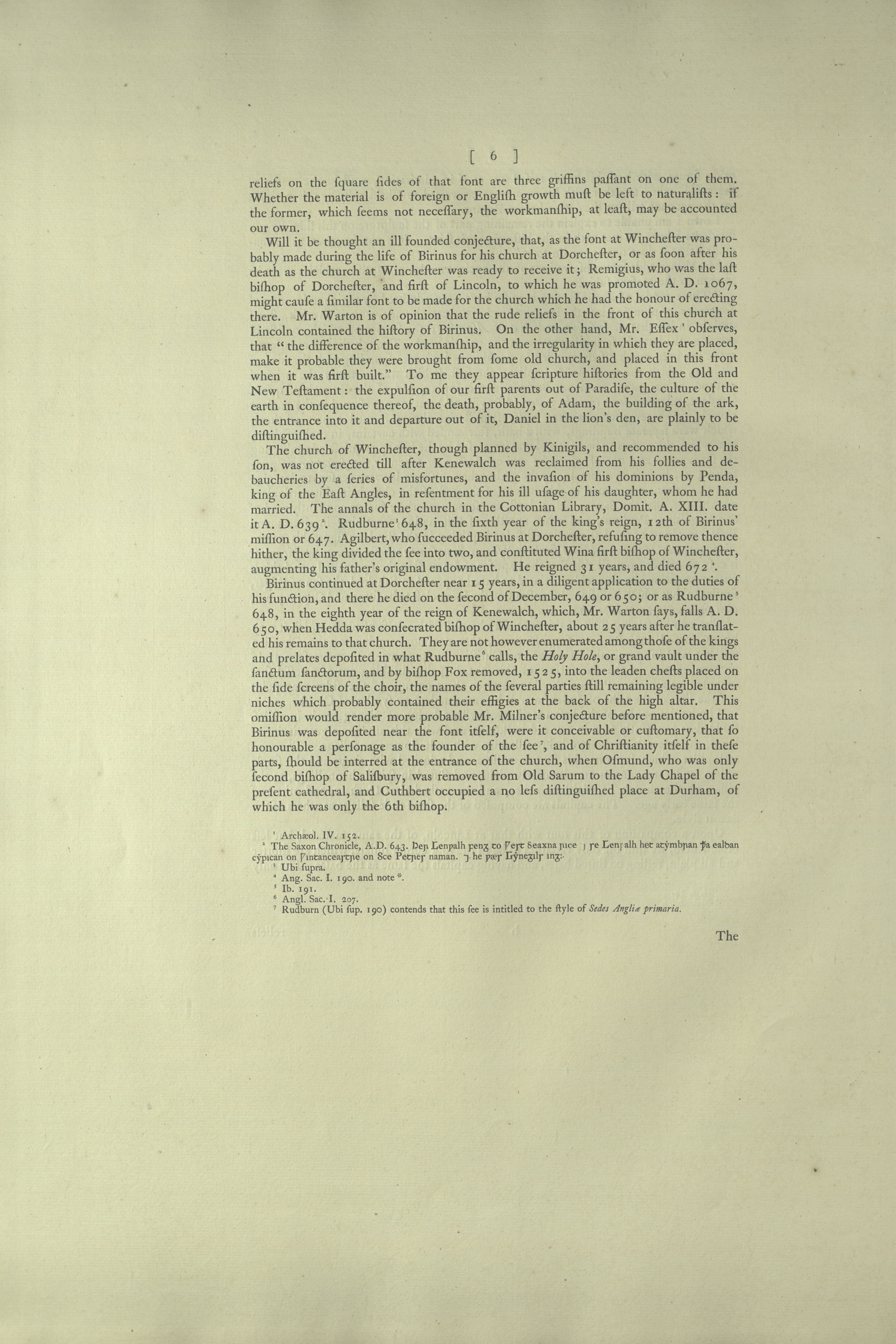
[ (Page) 6 ]
reliefs on the square sides of that font are three griffins passant on one of them. Whether the material is of foreign or English growth must be left to naturalists: If the former, which seems not necessary, the workmanship, at least, may be accounted our own.
Read more/less...Will it be thought an ill founded conjecture, that, as the font at Winchester was probably made during the life of Birinus for his church at Dorchester, or as soon after his death as the church at Winchester was ready to receive it; Remigius, who was the last bishop of Dorchester, and first of Lincoln, to which he was promoted A.D. 1067, might cause a similar font to be made for the church which he had the honour of erecting there. Mr. Warton is of opinion that the rude reliefs in the front of this church at Lincoln contained the history of Birinus. On the other hand, Mr. Essex1 observes, that “the difference of the workmanship, and the irregularity in which they are placed, make it probable they were brought from some old church, and placed in this front when it was first built.” To me they appear scripture histories from the Old and New Testament: the expulsion of our first parents out of Paradise, the culture of the earth in consequence thereof, the death, probably, of Adam, the building of the ark, the entrance into it and departure out of it, Daniel in the lion’s den, are plainly to be distinguished.
The church at Winchester, though planned by Kinigils, and recommended to his son, was not erected till after Kenewalch was reclaimed from his follies and debaucheries by a series of misfortunes, and the invasion of his dominions by Penda, king of the East Angles, in resentment for his ill usage of his daughter, whom he had married. The annals of the church in the Cottonian Library, Domit. A. XXII. date it A.D. 6392. Rudburne3 648, in the sixth year of the king’s reign, 12th of Birinus’ mission or 647. Agilbert, who succeeded Birinus at Dorchester, refusing to remove thence hither, the king divided the see into two, and constituted Wina first bishop of Winchester, augmenting his father’s original endowment. He reigned 31 years, and died 6724.
Birinus continued at Dorchester near 15 years, in a diligent application to the duties of his function, and there he died on the second of December, 649 or 650; or as Rudburne5 648, in the eighth year of the reign of Kenewalch, which, Mr. Warton says, falls A.D. 650, when Hedda was consecrated bishop of Winchester, about 25 years after he translated his remains to that church. They are not however enumerated among those of the kings and prelates deposited in what Rudburne6 calls, the Holy Hole, or grand vault under the sanctum sanctorum, and by bishop Fox removed, 1525, into the leaden chests placed on the side screens of the choir, the names of the several parties still remaining legible under niches which probably contained their effigies at the back of the high altar. This omission would render more probable Mr. Milner’s conjecture before mentioned, that Birinus was deposited near the font itself, were it conceivable or customary, that so honourable a personage as the founder of the see7, and of Christianity itself in these parts, should be interred at the entrance of the church, when Osmund, who was only second bishop of Salisbury, was removed from the Old Sarum to the Lady Chapel of the present cathedral, and Cuthbert occupied a no less distinguished place at Durham, of which he was only the 6th bishop.
1Archaeol. IV. 152
2The Saxon Chronicle, A.D. 643.
3Ubi supra.
4Ang. Sac. I. 190. and note *.
5Ib. 191.
6Angl. Sac. I. 207.
7Rudburn (Ubi sup. 190) contends that this see is intitled to the style of Sedes Angliae primaria.
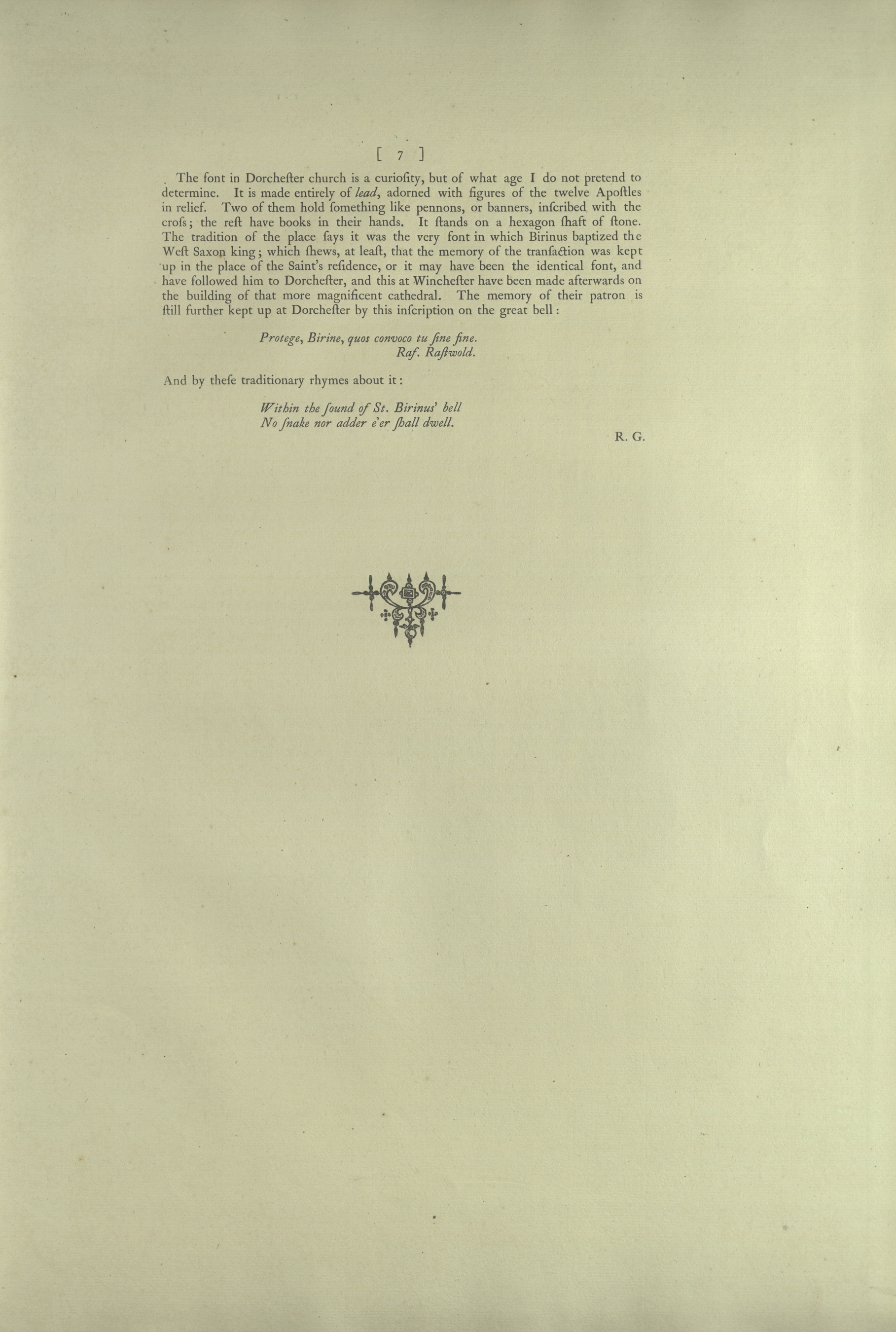
[ (Page) 7 ]
The font in Dorchester church is a curiosity, but of what age I do not pretend to determine. It is made entirely of lead, adorned with figures of the twelve Apostles in relief.
Read more/less...Two of them hold something like pennons, or banners, inscribed with the cross; the rest have books in their hands. It stands on a hexagon shaft of stone. The tradition of the place says it was the very font in which Birinus baptized the West Saxon king; which shews, at least, that the memory of the transaction was kept up in the place of the Saint’s residence, or it may have been the identical font, and have followed him to Dorchester, and this at Winchester have been made afterwards on the building of that more magnificent cathedral. The memory of their patron is still further kept up at Dorchester by this inscription on the great bell:
Protege, Birine, quos convoco tu sine fine.
[You, Birnus, protect forever those whom I summon.]
Raf. Rastwold.
And by these traditionary rhymes about it:
Within the sound of St. Birinus’ bell
No snake nor adder e’er shall dwell.
R.G.